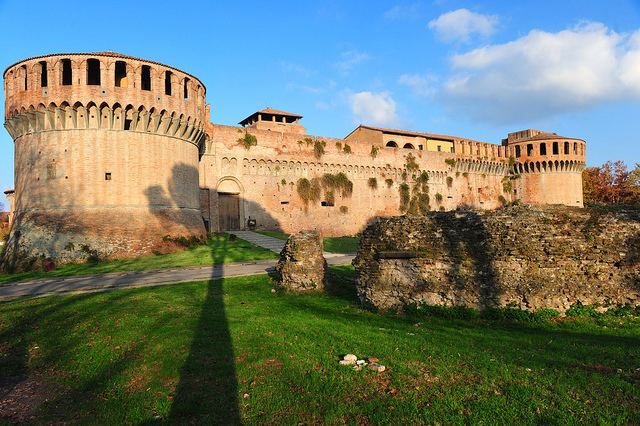Demonym(s) Imolesi Province Province of Bologna | Elevation 47 m (154 ft) Local time Saturday 10:31 AM | |
 | ||
Frazioni Cantalupo, Càsola Canina, Chiusura, Fabbrica, Giardino, Linaro, Montecatone, Piratello, Ponticelli, San Prospero, Sasso Morelli, Selva, Sesto Imolese, Spazzate Sassatelli, Zello Weather 12°C, Wind E at 10 km/h, 44% Humidity Points of interest Rocca Sforzesca di Imola, Palazzo Tozzoni, Parco delle Acque Minerali, Ayrton Senna da Silva, La Collezione Benito Ba | ||
Imola [ˈiːmola] (Emilian: Iommla, Romagnol: Jômla/Jemula) is a town and comune in the Metropolitan City of Bologna, located on the river Santerno, in the Emilia-Romagna region of northern Italy. The town is traditionally considered the western entrance to the historical region Romagna.
Contents
- Map of 40026 Imola Metropolitan City of Bologna Italy
- History
- Main sights
- Green areas
- People
- Medals and awards
- International relations
- References
Map of 40026 Imola, Metropolitan City of Bologna, Italy
The city is most noted as the home of the Autodromo Enzo e Dino Ferrari which formerly hosted the Formula One San Marino Grand Prix (the race was named after the nearby independent republic of San Marino, as Monza already hosted the Italian Grand Prix), and the deaths of Formula One drivers Ayrton Senna (Brazilian) and Roland Ratzenberger (Austrian) at the circuit during the 1994 San Marino Grand Prix. The death of Senna (three-times world champion) was an event that shocked the sporting world and changed Formula One safety standards for good.
History
The city was anciently called Forum Cornelii, after the Roman dictator L. Cornelius Sulla, who founded it about 82 BC. The town was an agricultural and trading centre, famous for its ceramics.
The name Imola was first used in the 7th century by the Lombards, who applied it to the fortress (the present Castellaccio, the construction of which is attributed to the Lombard Clefi), whence the name passed to the city itself. According to Paul the Deacon, Imola was in 412 the scene of the marriage of Ataulf, King of the Visigoths, to Galla Placidia, daughter of Emperor Theodosius the Great. In the Gothic War (535–552), and after the Lombard invasion, it was held alternately by the Byzantines and barbarians.
With the exarchate of Ravenna it passed under papal authority. In the ninth century it was bravely defended against the Saracens and Hungarians by Fausto Alidosi. In the tenth century Troilo Nordiglio acquired great power. This and the following centuries witnessed incessant wars against the Ravennatese, the Faentines and the Bolognese, as well as the internecine struggles of the Castrimolesi (from Castro Imolese, "castle of Imola") and the Sancassianesi (from San Cassiano). Amid these conflicts was formed the republican constitution of the city. In the contest between pope and emperor, Imola was generally Ghibelline, though it often returned to the popes (e.g. in 1248). Several times, powerful lords attempted to obtain the mastery of the city (Alidosi, 1292; Maghinardo Pagano, 1295). Pope Benedict XII turned the city and its territory over to Lippo II Alidosi with the title of pontifical vicar, the power remaining in the family Alidosi until 1424, when the condottiero Angelo della Pergola, "capitano" for Filippo Maria Visconti, gained the supremacy (see also Wars in Lombardy). In 1426 the city was restored to the Holy See, and the legate (later Cardinal) Capranica inaugurated a new regime in public affairs.
It was later ruled by various condottieri, such as the Visconti, from which era several landmark fortresses remain. In 1434, 1438 and 1470 Imola was conferred on the Sforza, who had become dukes of Milan (Lombardy). It was again brought under papal authority when it was bestowed as dowry on Caterina Sforza, the bride of Girolamo Riario, nephew of Pope Sixtus IV. Riario was invested with the Principality of Forlì and Imola. This proved advantageous to Imola, which was embellished with beautiful palaces and works of art (e.g. in the cathedral, the tomb of Girolamo, murdered in 1488 by conspirators of Forli). The rule of the Riarii, however, was brief, as Pope Alexander VI deprived the son of Girolamo, Ottaviano, of power, and on 25 November 1499, the city surrendered to Cesare Borgia. After his death, two factions, that of Galeazzo Riario and that of the Church, competed for control of the city. The ecclesiastical party was victorious, and in 1504 Imola submitted to Pope Julius II. The last trace of these contests was a bitter enmity between the Vaini and Sassatelli families.
In 1797 the revolutionary French forces established a provisional government at Imola; in 1799 it was occupied by the Austrians; in 1800 it was united to the Cisalpine Republic. After that it shared the fortunes of the Romagna region.
Main sights
Other buildings include the Farsetti and the Communal palaces. In the latter is a fresco representing Clement VII and Charles V (1535) passing through the city. The public library was established in 1747 by the Conventual Padre Setti. In the 16th century, the Accademia degli Industriosi flourished.
Green areas
People
Medals and awards
International relations
Imola is twinned with:
